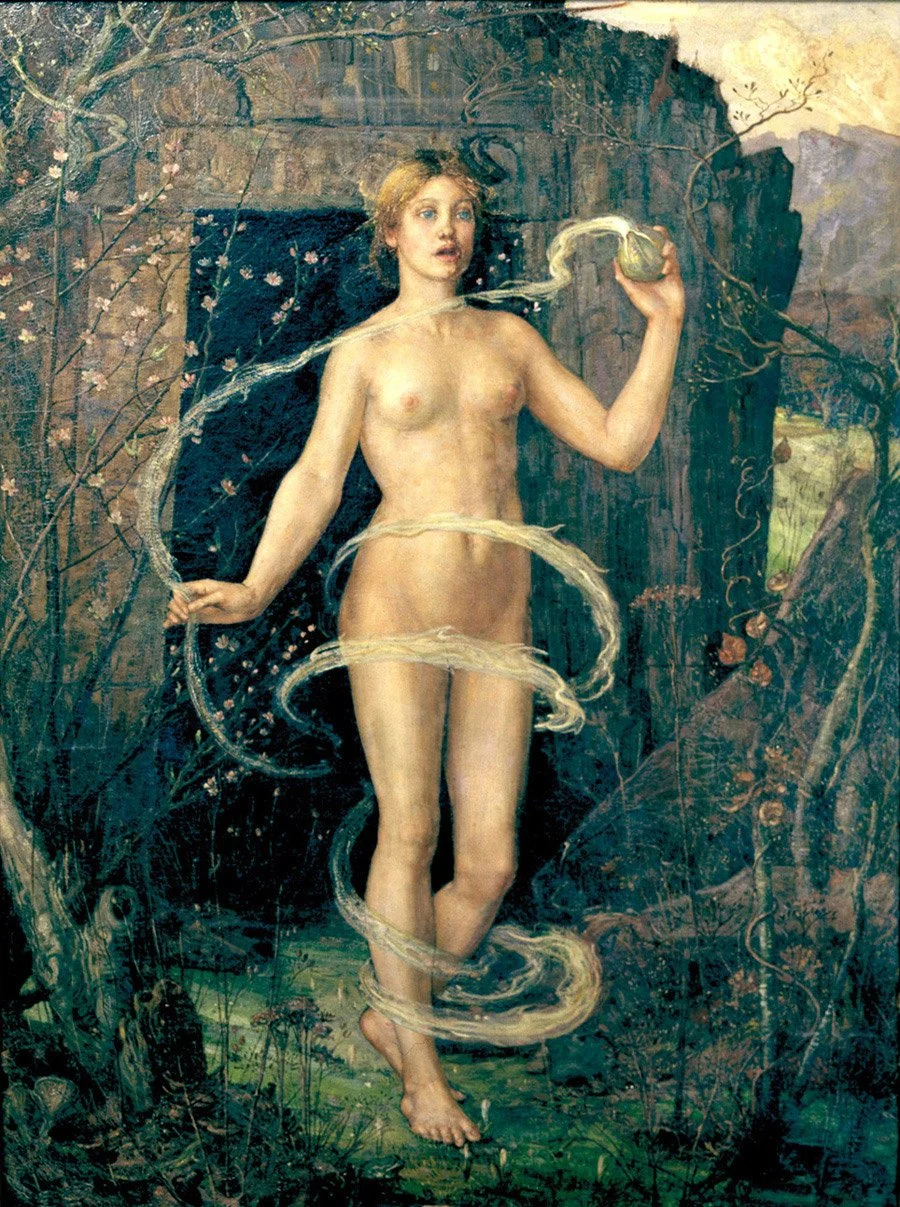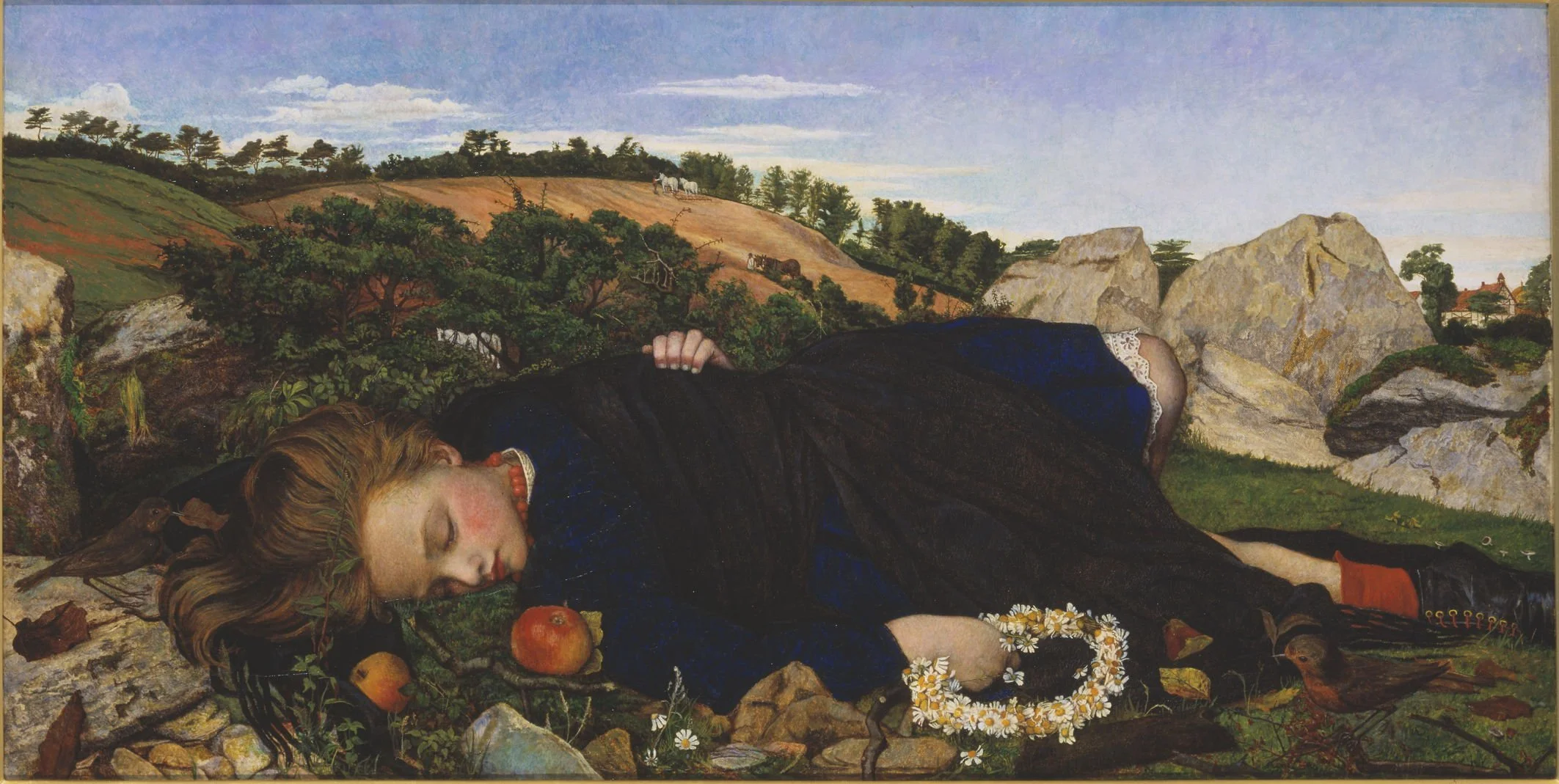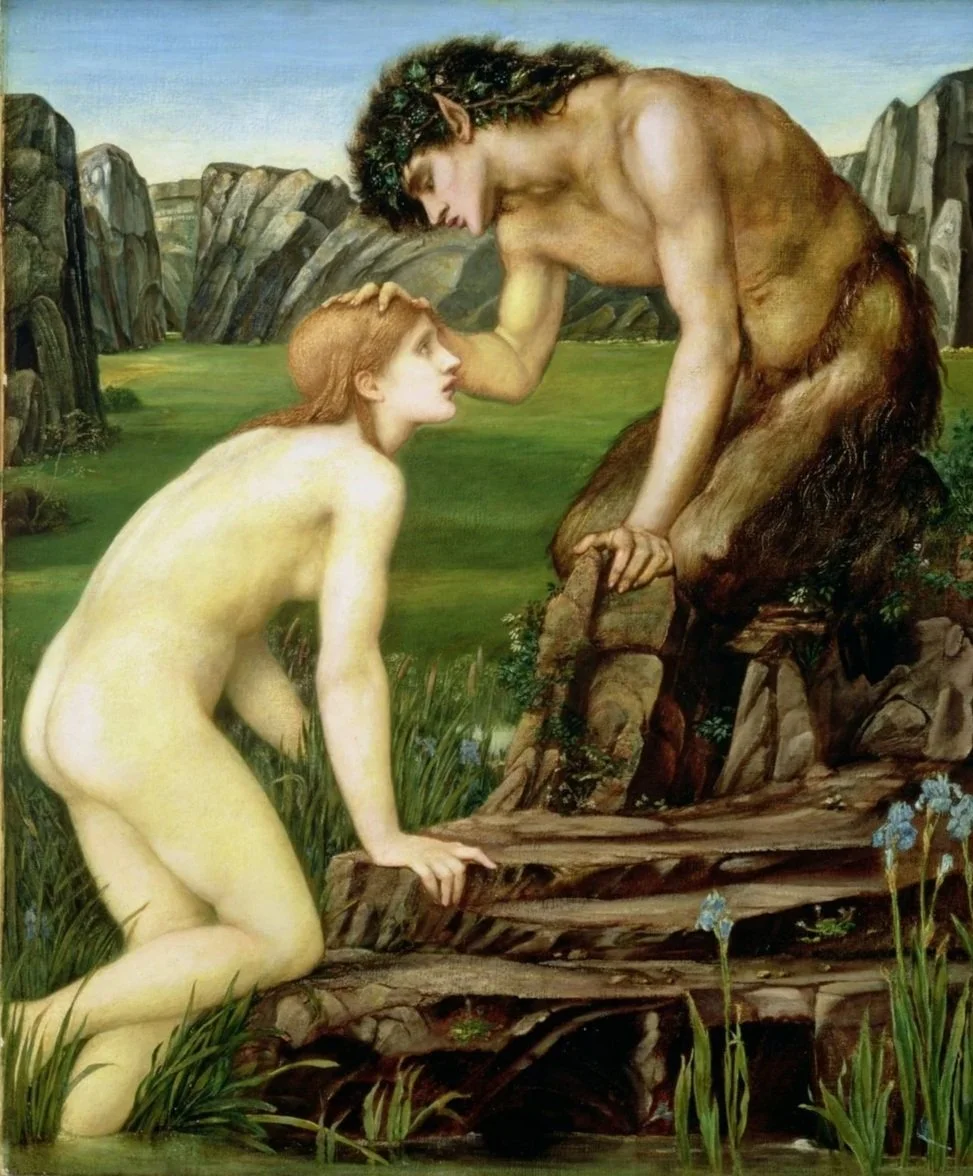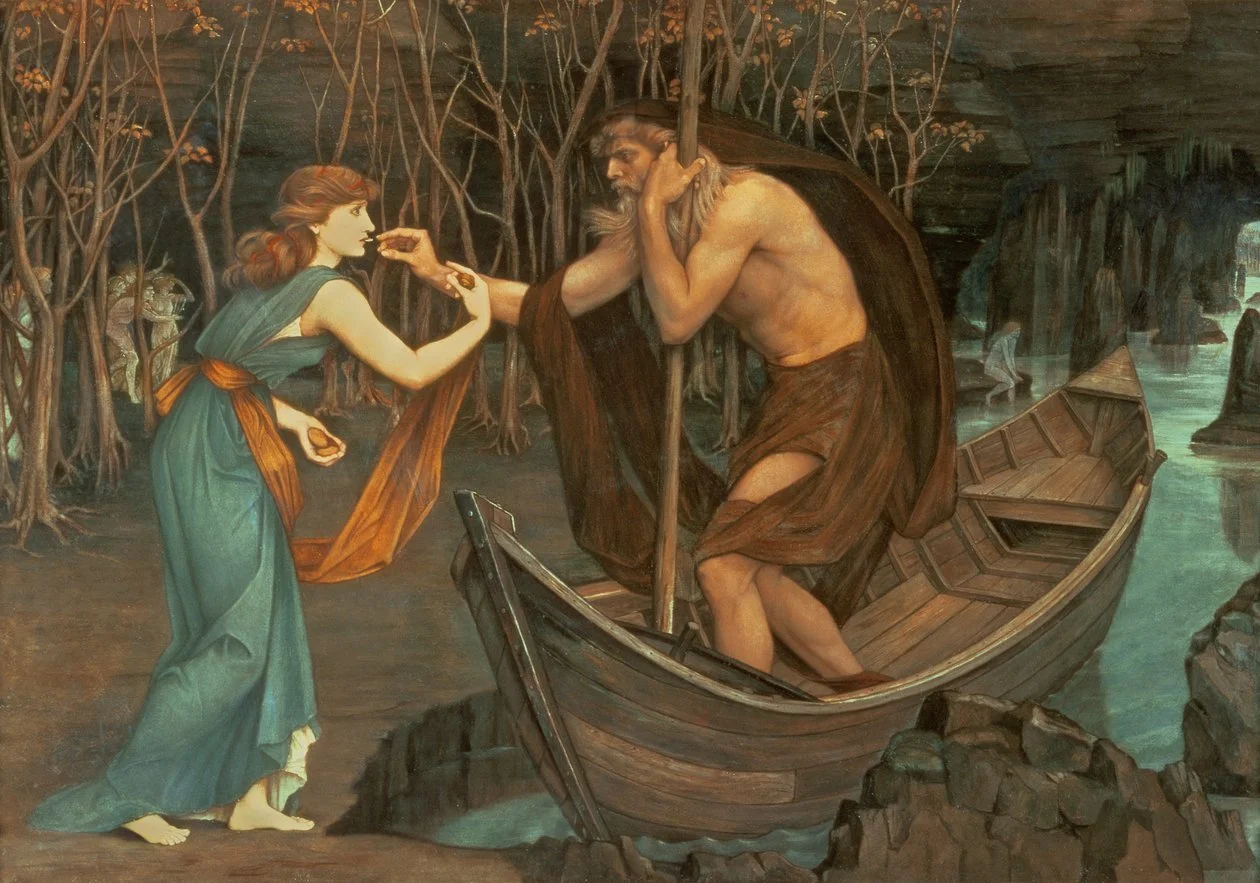The Monster’s Grief and the Feminine Wound
A descent into erotic healing, mythic encounter, and the scar that wants to reweave the story.
The Spring Witch - George Wilson (circa 1880)
Prologue: From Spell to Scar
Let’s get this straight out of the gates: neither the spell nor the scar is pathological, nor should they be nursed forever as badges of honor in a misguided power trip. Both are two sides of the portal—the site of transformation, a mythic before and after. It may bleed, ache, and throb with memory, but it is where rupture becomes ritual. In case you’re wondering, ritual is about saying: this moment, this aspect, this expression—matters. It doesn’t have to be fancy or complicated.
Forget needing to utter wyrd-sounding words or dance around a fire. It’s about doing something with intention, where even washing the dishes can be a ritual act. Rituals help us mark change, be present with the feelings that rise, weave in meaning—whatever that is for you—and acknowledge and honor what is hard, celebrate what is true, and remind ourselves: I’m here, and this matters. It’s about transforming things that would otherwise be dismissed as banal into something that carries meaning, and thus imbuing them with a sprinkle of the sacred.
If “The Monstrous Beloved and the Sovereign Feminine“ was the spell—the mythic incantation that named the wound and broke the curse—then this piece is the scar. In the first article of this series—What Women Want: Monsters, Sovereignty, and the Erotic Return of the Repressed—Lady Ragnell showed us what happens when the grotesque is revered, and sovereignty is restored through erotic agency and relational repair.
But her story, after we cross the portal of the spell, leaves behind a deeper question:
what of the wound that shaped her?
What of the feminine wound that predates the romance, the one that lives in the body, the psyche, and is reflected in the cage of the culture?
This deeper question is about the scar that pulses with possibility. But for what?
We’ve crossed the portal into the descent of the scar itself. This is the gash of the wound of being softened into maddening ‘perfection,’ silenced, sacrificed by those who relentlessly hold on to power and white-knuckle dying. It’s the scar-wound of being loved in fragments, where only the ‘good bits’ are cherished, and the rest is buried down into the dark recesses of self and culture. Remember, the scar of this wound is not a dead end—it’s the very doorway we need to cross.
The wound and its scar demand engagement—an erotic and pulsating aliveness in the encounter.
It’s not about ‘just sex,’ although sex is an alchemical crucible;
it’s about sensation, connection, and presence.
It’s the ‘hell ya‘ spark that says: I’m here, I feel this, and I want more. It’s way more than pin-up Aphrodite and her cute, chubby cupid. Eros—thus erotic—is presence pulsating with aroused life, not beige existence.
Robin of Modern Times (1860) - John Roddam Spencer Stanhope
When Scars Have Names: Naming the Wound
The feminine wound isn’t a single heartbreak—it’s a long lineage of scars crisscrossed in a pattern of beauty, rage, and desire. It’s the thrumming grief of being adored in fragments: the muse, the maiden, the mother, the mystery—but never whole. It’s the burnout of having to soften for others’ comfort, silenced for others’ fragile, power-hungry egos, and sacrificed for others’ main character stories. These scars live not only in the psyche and in the epigenetic cells—they shape the body’s expression through the clenched jaw, the tight hips, the breath held too long.
These scars have long memories. They’re older than religion and perhaps even civilization as we know it. These are scars cut from someone else’s gaze, made from having to follow their rules and rhythms. It’s vital that we name the scar—not to wallow, not to stay stuck—but to witness and stir. Because when we name the wound, we begin to reclaim the story. And when we reclaim the story, we stop being the admired-from-afar muse and start being the sovereign author—the one who originates and creates.
So what’s the name of the wound? It’s being made into a kaleidoscopic fragmentation,
but never held in wholeness.
It’s the fracture that happens when we’re shaped by someone else’s gaze and rhythm, and taught to shrink to fit. Fragmentation isn’t just aesthetic—it’s both existential and relational.
Naming the wound isn’t about blame—it’s about breaking the spell. Just as the heroine who utters Rumpelstiltskin’s name frees herself from his power, naming is liberation. The feminine wound isn’t just about what was done to us—it’s part of the internalized hush, the generational script that says: be small, be sweet, be safe. It’s woven into the very fascia of our beings, holding it all together in a lemniscate of inherited sense of self.
While this piece centers the feminine wound, let’s be clear: the wound itself is relational. It belongs to both the feminine and the masculine. The masculine carries its own grief, its own distortions, and aches. However, we begin with the feminine descent. Not because she needs saving, but because she needs space—to feel, to speak, to reclaim.
Healing doesn’t happen in isolation, but in encounter.
This encounter is at the core of why the heroine and the monster are drawn together. It’s never by accidental whimsy or coincidence—it’s by the mythic design of the Fates. The pull between shadow and sovereignty is foundational to their fated attraction because both carry pieces of the wound, and both must show up for the healing.
And let’s be very clear about this: it is not about saying the feminine can only be healed by the masculine. That’s the old spell, and it’s shattered into smithereens. This is about saying: we need each other—not to complete ourselves like old pots and their missing lids—but to witness the other, not rescue. It’s about re-membering—bringing the fragmented parts together, both loved, but especially the discarded ones.
A welcoming reunion for the return of the repressed, both in the feminine and in the masculine. For when a wound is relational, so must the healing be.
The feminine doesn’t need the masculine to be whole—remember, we are not pots with missing lids. But she does need the masculine to meet her there: in the cave, in the scar, in the story. And he, too, needs her. Because this isn’t a solo journey—it’s a descent tango dance.
Orpheus and Eurydice (1878) - John Roddam Spencer Stanhope
The Fated Encounter with the Monster: The Threshold Dweller
If the feminine wound is the scar, the monster is the one who meets us there. He doesn’t arrive with bandages or balm. He arrives with teeth, shadow, and a gaze that doesn’t flinch. Plus a good dose of growling—even sneering. He’s not there to fix anything. He’s there to feel with us.
He’s not the rescuer. He’s a mirror. He is also the threshold dweller.
As a threshold dweller, he is the one who waits at the edge of transformation. Not inside the old story, not yet in the new one, but right at the doorway. One can’t go to the other side without facing them. They may or may not push or pull us. Some will attract us to them. Others will snarl us away. Whatever the manner, they say, ‘If you’re ready, come closer.’ In myth, they aren’t always the monster. At times, they show up as the guide, the testing deity, or the lover who doesn’t flinch. In life, they’re the ones who hold space for change, awaiting us where rupture happens and the scar bleeds anew.
In our modern mythic reimagining, monster romances dare us to imagine what that might look like: two wounded parts drawn together not to fix, but to feel, witness, and learn to relate. It’s not about taming or dominating, but about transforming and touching the truth of what’s been waiting to be healed.
This is why the heroine and the monster are often fated mates in monster romances.
Not because one completes the other, but because their union is the ritual
site of relational healing.
The erotic pull between them isn’t just desire—it’s destiny*. It’s the body’s way of saying, ‘We cannot heal alone.’ We must meet in the wound—in the moldy, neglected corners of its shadow—and in its longing hunger for belonging. From this fated meeting, something alchemical finally stirs. Anything else is just performative.
In monster romance, the monster is not a threat to the heroine’s autonomy. He’s a container for it. He doesn’t shrink from her rage, her grief, her hunger. He holds it and loves her through it. He isn’t there to tame her—but to revere.
This is why the monster is compelling as a Threshold Dweller. He bypasses the mind’s need for control and speaks directly to the body, the instinct, the erotic pulse: “Come closer.” He is danger—but danger that awakens. He is hideous—but hideousness that reveals. He is the Other—both within and without.
The monster isn’t only a mirror to the unclaimed and unacknowledged parts of the feminine: carrying her rage and fury, the appetite that was punished, the desire that was named sin. He also holds the grief of the masculine: the shame, the distortion, the vulnerable—and yet silenced—longing to be whole. As such, he’s a disturbance in the force because the monster is the vessel for what culture can’t hold.
And so, when the heroine meets the monster, it’s not just a love story. It’s a ritual descent for the reclamation of lost and repressed parts. The heroine doesn’t just fall for him—she rises through him. And he, in turn, is transformed by her gaze—not into a prince, but into a partner. He stays hideous in his form, because it’s not about perfection, but relational presence.
Together, they stand at the threshold. As erotic catalysts. Not as Muse and Monster, but as co-conspirators in the burning down of this old cage.
Eve (1908) Solomon Joseph Solomon
Orgasmic Desire: Erotic Encounter as Cultural Healing
Let’s be clear: the erotic encounter between heroine and monster isn’t just spicy—it’s symbolic and sacred. Sure, titillation may beckon us closer, but their union is about relationally erotic transformation. Because when the feminine wound meets the monster’s gaze, something ancient stirs: the scar pulses, the body remembers, and the old cage that has kept both as prisoners begins to crack.
Judging these stories by their cover, one may think it’s a rescue fantasy—but it’s a ritual rehearsal. The monster, in his shadowed devotion, becomes the one who can hold her rage, her grief, her hunger without flinching. He isn’t there to save her, fix her, or tame her. He’s there to revere her wholeness. Because she’s not there to be saved—she needs to be witnessed, accepted, and in return, to witness and accept the monster in their fated relational healing.
In this erotic encounter, the wound doesn’t get erased by plastic surgery to make it all smooth and perfect. The scar is not hidden—it is kissed. And the heroine, long fragmented by cultural scripts, begins to feel whole. Not because the monster completes her, but because he meets her. Fully. Fiercely. Without turning away. His ego isn’t a tiny studio in the Upper West Side that can’t accommodate another. He inhabits the edge of a dark cavern at the threshold and isn’t afraid of a bit of teeth or darkness.
This is why monster romance matters. It’s not fluff. It’s mythic medicine. It’s the recurring dream we keep having because we haven’t lived it—yet. It’s the rehearsal for relational sovereignty; for love that doesn’t shrink from shadow, ready for the orgasmic erotic encounter that might bring a wave of cultural healing.
Because the erotic encounter isn’t just personal—it’s archetypal. Like in a dream, it signals that something is ready to come together. It’s the moment when the fragmented parts—body, psyche, culture—begin to cohere. The erotic is the pulse of integration. It releases what’s been pent up: grief, rage, longing, images too wild for polite society. And in that release, the cultural field shifts. The force field of repression thins. The morphogenetic field—the energetic blueprint of culture—gets cleansed, rewired, re-enchanted.
This isn’t just Marvin Gaye’s “Sexual Healing” (though the pun is delicious). It’s mythic healing. Erotic encounter as cultural exorcism. As sacred play. As the moment when the heroine and the monster meet not just in flesh, but in myth—and something ancient, aching, and holy begins to mend.
Sure, these books can be sexy. Because being seen in your fullness is erotic.
Because when the monster and the heroine meet in the cave of the wound,
they don’t just make love—they make myth.
Pan and Psyche (1872-1874) by Edward Burne-Jones
Beyond Complaint—Toward Story-Weaving
Now it’s time to move beyond the complaint. Yes, the system is wounded. Yes, patriarchy has distorted the dance. However, if we remain stuck in merely naming the problem, we risk becoming curators of complaints rather than creators of change. The wound needs to be witnessed—but it also needs to be worked with, not frozen on the altar of how wronged we’ve been.
At an archetypal level, monster romance doesn’t just name the problem—it rehearses the solution. It doesn’t just critique the cage—it burns it down. And in doing so, it invites us to become story-weavers, not just muses. Not just heroines waiting to be chosen, but co-creators of erotic, relational, cultural transformation.
This is why the genre persists, why it sells, why it stirs. Because it’s not ‘just’ fantasy, it’s the dream we keep dreaming because we know, deep down, that we cannot heal alone. That the feminine wound and the masculine grief must meet. Must converge and reweave their story.
So let’s stop dismissing these stories as fluff.
Let’s stop apologizing for our longing.
Let’s start seeing monster romance as an archetypal healing rehearsal. As an erotic ritual. As cultural medicine. Because when the heroine and the monster meet—not in fantasy, but in felt truth—they don’t just rewrite the story—they re-enchant the world.
Charon and Psyche (1883) by John Roddam Spencer Stanhope
The Scar as Spell—The Danger of Staying Stuck
We end where we began: with the scar. Not as a mark of damage, but as a roadmap to both descent and healing—as in the true sense of the word: become whole. But the scar can, and is becoming, an enchanted spell.
The risk of fixation is not leading toward healing, but a battleground of semantics in our culture of grievance. Because when we stay stuck in the wound and its memory of rupture—when rage and grief become our only language—we risk turning the scar into the cage’s new iron chains.
This is the danger of staying in the old narrative: we mistake the ache for identity.
We overfixate on the pain but forget the possibility.
And culturally, we often dismiss the recurring dream as fluff, fantasy, or a “women’s thing,” when in truth, it’s an imaginal roadmap—a mythic rehearsal for the alchemical union of feminine and masculine—a story-weaving that wants to unfurl.
And remember, the monster has never left our stories. He’s always been there—at the edge, in the cave, in the shadow—our ever-present threshold dweller. Not to frighten us, but to invite us. He holds both a clue and a key—because he also holds what human men often cannot: the feminine rage, the erotic hunger, the sacred grief. He doesn’t flinch. He doesn’t fix. He waits.
So let the scar shine—but don’t let it trap you.
Let it pulse—but don’t let it possess you.
Let it guide—but let it guide you forward.
Because in this mythic descent, the scar is not just what you survived.
It’s the portal through which we all have to go to break the spell that’s holding us fragmented, divided, and conquered.
Monster stories beckon us to cross the threshold and meet its dweller. They beckon us to reweave the story with the discarded, fragmented parts that need to return home.
Which is where we go next.
In Article 3: Monstrous Devotion and Erotic Sovereignty, we’ll explore how the monster becomes not just a mirror, but a ritual partner—one who holds without controlling, reveres without taming. We’ll ask: What if love didn’t fix you, but worshipped your wholeness?
And in Article 4: Monster Romance as Cultural Counterspell, we’ll explore why the grotesque is sacred, why the erotic is political, and how reading becomes ritual. We’ll ask: What if pleasure was the portal to transformation? The scar opened the door.
Now we walk through it.
*Desire is the ache. Destiny is the arc. Desire comes from de sidere—”from the stars”—a longing shaped by celestial pull. Destiny, from destinare, means “to make firm, to establish.” One is the hunger that moves us; the other is the path that rises to meet it. Desire initiates. Destiny affirms. The heroine doesn’t just want the monster—she’s drawn to him by something older than want. And he, too, is shaped by that same pull. Their meeting isn’t random—it’s written. It’s the ritual choreography of longing and becoming.
May the Power of Fluff be with you.
Vanessa Couto





